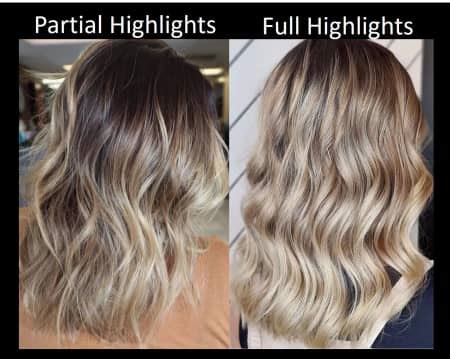Introduction
Stepping into the salon, your stylist inquires about your hair highlight aspirations. Should you opt for partial highlights, focusing on specific sections, or embrace full highlights, illuminating your entire head? This guide unravels the nuances of partial vs. full highlights, empowering you to make an informed decision that complements your unique style and hair goals.

Partial Highlights: The Art of Subtlety
Definition: Partial highlights strategically target specific sections of hair, typically around the face or crown. This technique adds subtle dimension and a touch of brightness without altering your overall hair color dramatically.
Benefits:
– Creates a natural, sun-kissed look
– Enhances facial features and contouring
– Low maintenance and less damaging than full highlights
Types of Partial Highlights:
– Foilyage: A freehand technique using foil to create precise, blended highlights
– Balayage: A softer, hand-painted method that mimics a natural gradient
– Teasing: Lifting hair strands to create more vibrant highlights
Full Highlights: Embracing Brilliance
Definition: Full highlights involve the application of highlights to the entire head of hair. This technique creates a more uniform and noticeable brightening effect.
Benefits:
– Dramatic transformation, adding significant lightness and depth
– Balances out hair color and covers grey effectively
– Can be customized to achieve different levels of brightness
Types of Full Highlights:
– Cap highlights: A traditional method using a rubber cap with perforations
– Global highlights: A more modern approach with highlights placed throughout the hair
– Reverse highlights: A technique that darkens the natural hair color for added dimension
Comparing Partial and Full Highlights
| Feature | Partial Highlights | Full Highlights |
|---|---|---|
| Coverage | Targeted sections | Entire head |
| Dimension | Adds subtle brightness | Creates more depth and contrast |
| Brightness | Natural, sun-kissed effect | More noticeable and dramatic |
| Maintenance | Low maintenance, requires touch-ups every 6-8 weeks | Requires more frequent touch-ups, every 4-6 weeks |
| Damage | Less damaging to hair | More damaging due to extensive processing |
Effective Strategies for Choosing
Consider Your Desired Look:
– Partial highlights: Ideal for those seeking a subtle enhancement or a natural, dimensional look.
– Full highlights: Best suited for those who desire a more dramatic transformation or to cover grey hair effectively.
Match Your Hair Type:
– Fine hair: Partial highlights add volume and texture, while full highlights may weigh down hair.
– Thick hair: Both partial and full highlights work well, but full highlights can provide more even coverage.
Consider Your Budget and Lifestyle:
– Partial highlights: Typically less expensive and require less maintenance.
– Full highlights: More costly and require more frequent touch-ups.
Tips and Tricks
Consultation with a Stylist:
Consult with an experienced hairstylist to discuss your specific hair goals and determine the most suitable highlight technique.
Color Placement:
The placement of highlights can greatly impact the overall effect. Discuss with your stylist the best sections to highlight based on your face shape and hair texture.
Toner or Gloss:
After highlighting, consider using a toner or gloss to add shine and neutralize unwanted brassy or yellow tones.
Home Care:
Use color-safe shampoo and conditioner to preserve the vibrancy of your highlights. Invest in a leave-in conditioner or hair mask to keep hair hydrated and healthy.
Pros and Cons
Partial Highlights:
-
Pros:
- Subtle and natural-looking
- Low maintenance and less damaging
- Can add dimension and lift facial features
-
Cons:
- May not be sufficient for drastic color transformations
- Requires touch-ups to maintain brightness
Full Highlights:
-
Pros:
- Dramatic and noticeable brightness
- Covers grey hair effectively
- Adds depth and dimension
-
Cons:
- More damaging to hair
- Requires frequent touch-ups
- Can be costly
Creative Applications
Ombré Blends with Highlights:
Combine partial highlights with an ombré technique to create a seamless transition from darker roots to lighter ends.
Peek-a-Boo Highlights:
Add subtle highlights underneath the top layer of hair for a peek-a-boo effect that adds intrigue and depth.
Colored Highlights:
Incorporate vibrant colors into your highlights for a bold and unique statement.
Conclusion
Whether you opt for partial or full highlights, the key is to choose a technique that complements your hair type, desired look, and lifestyle. Armed with the knowledge of each method’s benefits and considerations, you can collaborate with your stylist to achieve the perfect highlight transformation that enhances your natural beauty and boosts your confidence.
